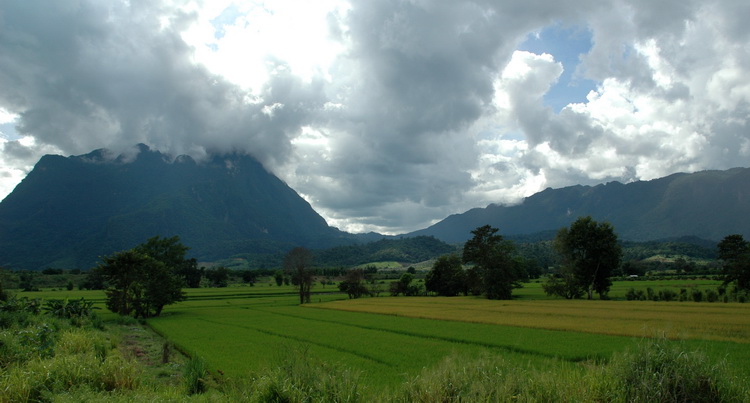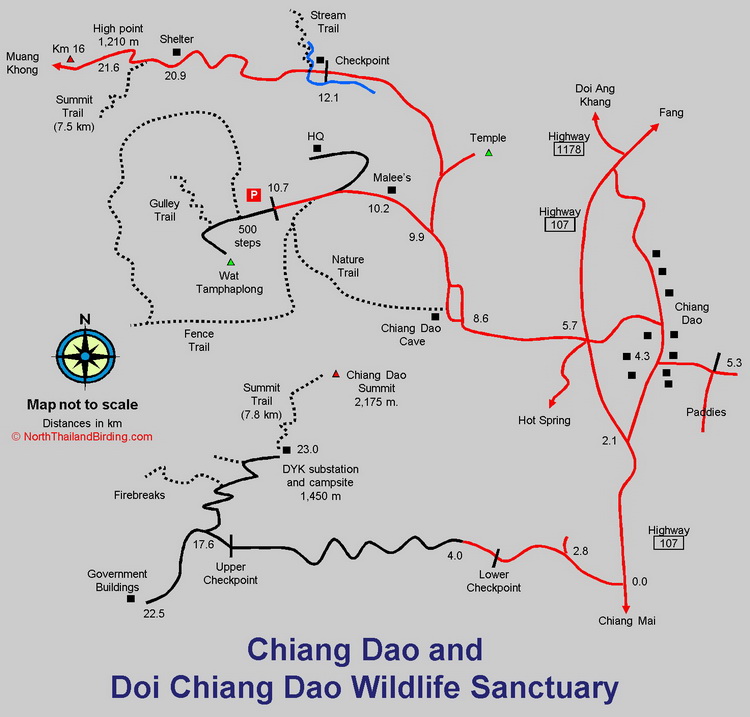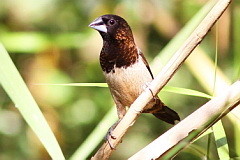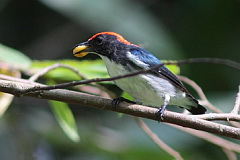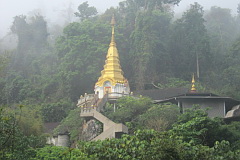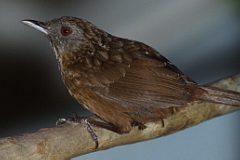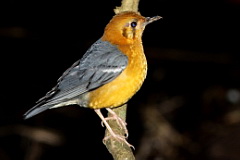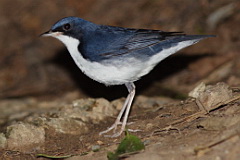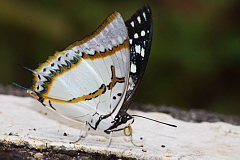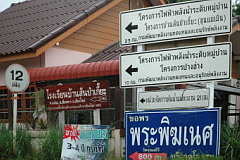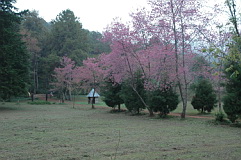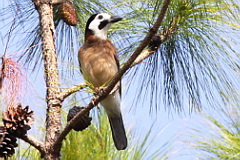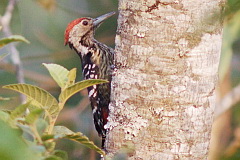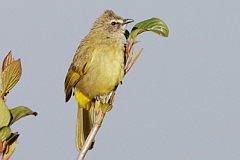Overview
The Chiang Dao area has a number of both birding and tourist attractions, making an excellent base for a few days. With access to various forested habitats of differing elevation, even a couple of days here can run up a sizeable species list. Information on this page verified/accurate as of 11 Jan 2024.
Doi Chiang Dao - 2,200
metres
The temple, Wat Tamphaplong, has impressively scenic surroundings, and the whole area has a rather relaxed atmosphere. Chiang Dao is often overlooked by visiting birders in preference for other sites, such as Doi Inthanon, due to those sites having larger species lists. However, some specialities such as Streaked Wren-Babbler, Giant Nuthatch and Mrs. Hume's Pheasant occur, which make a visit worthwhile.
Access
Chiang Dao town lies about 80 kilometres, just over an hour's drive, north of Chiang Mai. From Chiang Mai head north from the city on Highway 107, toward Fang and passing through Mae Taeng. Most visitors will want to stay away from Chiang Dao town itself, and be based at one of the resorts along the road passing Chiang Dao Cave toward Wat Tamphaplong. Coming from the south, this road is found off the by-pass, 3.8 kilometres after the right turn to Chiang Dao town, and is well marked with signs for the cave and various resorts. From this turning it's 2.9 kilometres to the cave and 5.0 kilometres to Wat Tamphaplong.
Accommodation and Facilities
A variety of accommodation, from camping, through back-backing guest houses to comfortable resorts can be found along the by-pass and particularly the road to Wat Tamphaplong. Most popular with birders are Malee's Nature Lovers Bungalows, and the adjacent Chiang Dao Nest 1. Other than at the resorts, small restaurants are found around Chiang Dao Cave as well as in town. A couple of 24 hour convenience stores are also located in town.
Camping, that requires a permit from the Headquaters, is available at higher altitude at the Den Ya Kat (DYK) substation inside the wildlife sanctuary. Facilities here are restricted to a simple toilet block, so take all food, water and camping equipment. Note that the road up to DYK requires a high clearance vehicle, as well as 4x4 in the wet season.
Birding
A number of areas and trails can be birded. As Chiang Dao is not a national park, but a wildlife sanctuary, a permit is required to access either the Meang Khong road, or the Doi Chiang Dao mountain road. These permits can be purchased in advance from the wildlife sanctuary HQ located between Malee's and Wat Tamphaplong, or at the checkpoint at the bottom on the Muang Khong road. Note that as the headquaters will only be open standard government office hours.
|
Usually it is necessary to provide vehicle type, registration number and driver details, as well as names of those in the group, their ages and the number of days planned to stay. Permits are valid for three days. The usual wildlife sancuary entrance fees are charged. Resorts Area The open areas, from Malee's toward Wat Tamphaplong, as well as in the other direction along the road to the checkpoint at the bottom of the Muang Khong road, offer birding of forest edge, open scrub and gardens. By simply walking along the road a large assortment of species to be found includes the likes of Purple Sunbird, Black-throated Sunbird, Red-whiskered Bulbul, Brown Shrike, Blue Rock Thrush, Chestnut-tailed Starling, Grey-breasted Prinia, Plaintive Cuckoo, Taiga Flycatcher, Yellow-browed Warbler and many many more. Night birding is also good with the following likely to be seen or heard - Brown Boobook, Collared Scops Owl, Asian Barred Owl, Large-tailed Nightjar and, rarely, Oriental Bay Owl. Others such as Collared Owlet, Mountain Scops Owl, Spot-bellied Eagle-Owl and Blyth's Frogmouth might be heard from the surrounding forest at the appropriate time of year. |
Nature Trail and Fence Trail
The Nature Trail, which also acts as the start of the Fence Trail, starts just after the entrance to the HQ, but before the temple gate, and is marked by a large wooden sign. The very start of this trail requires a drop into a short steep gulley which initially doesn't seem very promising, but once the trail enters the forest it's relatively easy to follow; especially in the dry season when well used. Unfortunately this trail is rather steep, but the habitat is a mixture of evergreen forest including large areas of bamboo and holds Bamboo Woodpecker. After 20 minutes climbing, at the top of the first ridge, the trail forks with the Fence Trail going off right. Both these trails are steep and several kilometres long, with the Nature Trail exiting at Chiang Dao Cave and the Fence Trail doing a long loop around the temple. As the trails are not particularly maintained use of a GPS is recommended in the event that they become difficult to follow. Birds along the start of the trail include Streaked Wren-Babbler, and for the very fortunate, Rusty-naped Pitta. A few other possibilities include Green-legged Partridge, Orange-breasted Trogon. Puff-throated Bulbul, Grey-eyed Bulbul, Brown-cheeked Fulvetta, Purple-naped Spiderhunter, Yellow-bellied Warbler, White-browed Scimitar Babbler, Orange-headed Thrush, Buff-breasted Babbler, Hainan Blue Flycatcher and White-crested Laughingthrush.
Wat Tamphaplong
The temple grounds, at an altitude just over 500 metres, hold a good selection of evergreen forest birds. A long series of 500 plus steps leads through this forest from the temple car park up to the temple itself. The view from the highest point of temple, where it is possible to scan the surrounding canopy, is excellent.
|
When entering the car parking area just inside the temple gate it's worth walking to the right, around the smaller shrine, as the tall forest here has Orange-breasted Trogon, Brown-cheeked Fulvetta, Dark-necked Tailorbird, Puff-throated Bulbul, Two-barred Greenish Warbler and others. Along the temple steps look for Streaked Wren-Babbler, Sultan Tit, Asian Barred Owlet, Speckled Piculet, and Blyth's Paradise Flycatcher. More open areas, and scanning from the temple, might produce Pin-tailed Green Pigeon, Wedge-tailed Green Pigeon, Mountain Imperial Pigeon, Brown-backed Needletail, Scarlet Minivet, Violet Cuckoo, Blue-throated Barbet, Great Barbet, Blue-winged Leafbird, Orange-bellied Leafbird or Asian Fairy Bluebird. It can be surprisingly chilly here during the cool season once the sun disappears behind the high surrounding mountains. At night Blyth's Frogmouth, Spot-bellied Eagle-Owl , Collared Owlet and Mountain Scops Owl are sometimes vocal. Gulley Trail The Gulley Trail, which follows a water pipe, starts about three quarters of the way up the steps to the temple, just after where the stream crosses under the steps. As this provides water to the temple it is very important not to stand or sit on the pipes as this would cause great offence to the monks. The dense vegetation here is of course much easier to access in the dry season, with leeches and potentially knee-deep water during the rains. How far it's possible to progress varies greatly with recent usage, but as far as the water storage tanks is usually easy. In the past it has been possible to link up with the Fence Trail. The understorey holds a number of skulkers including, Streaked Wren-Babbler, Eyebrowed Wren-Babbler, Western Hooded Pitta, Rusty-naped Pitta, Siberian Blue Robin, Slaty-backed Forktail and Northern White-crowned Forktail. Time and patience are required to get to grips with many of these birds. Muang Khong Road Access beyond the checkpoint requires the same permit as issued from the wildlife sanctuary office. It should be possible to reuse the same permit as used to ascend the mountain the previous day, or purchase a new ticket at the checkpoint. From the checkpoint the road climbs steeply up from about 500 metres to 1,210 metres passing through mixed evergreen, oak-pine and pine forests. Parking areas along the steep, winding lower sections of the road are somewhat limited. A day spent simply stopping and walking along this road is likely to produce some good species. The road can be busy at times as locals from Muang Khong travel back and forth with market produce to markets in Chiang Dao and beyond. It's well worth spending some time at the checkpoint and birding the higher trees in this area. It's also an excellent place for photographing butterflies in the dry season. The small stream flowing past here can be followed in the dry season and contains a usual selection of forest species including Green-legged Partridge. Flowering or fruiting trees will hold a collection of sunbirds, leafbirds and barbets. Square-tailed Drongo-Cuckoo and Yellow-vented Flowerpecker are regular in this area. It's also one of the few places where Oriental Pied Hornbill can be found in the north. The open pines at the highest parts of the road have been known to hold Giant Nuthatch, and scanning distant snags might find Oriental Hobby. More common species along the road include Blue-eared Barbet, Cinereous Tit, Grey Treepie, Laced Woodpecker, Mountain Tailorbird, Hill Blue Flycatcher and Indian White-eye. In the cool season the usual confusing batch of leaf warblers might hold Claudia's Leaf Warbler. |
A few hundred metres before the highest point of the road is a signposted trail to the summit. It's a stiff 7.5 kilometre walk, only open during the dry season, that few birders undertake, but passes through a succession of interesting forest with Crested Finchbill and Brown-breasted Bulbul. Beyond the summit of the road, forest continues down the other side for at least another 15 kilometres, with the altitude ranging down to about 600 metres. As the slope is gentle, long stretches are easy to walk and the birding from the roadside can be good. This area has not been well explored.
Doi Chiang Dao
The impressive Doi Chiang Dao, dominates much of the surrounding countryside, and when viewed from the main highway seems impossibly steep to access. The mountain itself, at 2,200 metres, is the third highest peak in Thailand. The upper parts of this mountain lie within the Doi Chiang Dao Wildlife Sanctuary.
|
Fortunately for birders a long arduous trek to the summit is not required to find the specialities of the area. Most birders simply undertake a long, day trip based from Chiang Dao. For those with more time it's possible to camp at the DYK sub-station and really explore the surrounding area, which is a good location for Hodgson's Frogmouth. A good plan is to arrive by first light at DYK as both Mrs. Hume's Pheasant and Giant Nuthatch are most often found in this area, though in recent years the nuthatch is become inexplicably scarcer. Having obtained a permit from the HQ the previous day, leave Chiang Dao early, allowing about one and a half hours for the ascent. A high clearance vehicle is required, and a 4x4 necessary in the wet. A saloon car cannot reach DYK. Due to continued road works, unbelievably ongoing for the past ten years, along the highway south of Chiang Dao, finding the small turn off up the mountain is not straightforward. Previous landmarks have been removed and any signs are in Thai (see photo for current signage). The easiest way to find the turning is to measure exactly 2.1 kilometres from the junction from the by-pass into Chiang Dao town. The road up the mountain is paved for four kilometres, after which it is clay; heavily rutted by the rains. Birding can be good anywhere after the lower checkpoint, but birders searching for the specialities should resist the temptation to stop en route. After 17 kilometres the upper checkpoint is reached, 300 metres after which the main track forks, with DYK a hard right turn on a progressively deteriorating track. All the habitat above the upper checkpoint is good for both the nuthatch and pheasant, and stopping anywhere is likely to produce a number of interesting species. A number of firebreaks and wide trails run off this track, and can be explored. Giant Nuthatch can often be heard around the campsite at DYK early morning. Searching for Mrs. Hume's Pheasant can be a matter a luck but any of the tracks and trails can produce this bird. The pond at the DYK has held Black-tailed Crake in the past. Early morning at the DYK campsite can be particularly productive with mixed flocks containing all three white-eyes - Swinhoe's White-eye, Indian White-eye and Chestnut-flanked White-eye. Other birds in surrounding scrub and trees can include Bay Woodpecker, Stripe-breasted Woodpecker, Chinese Leaf Warbler, Buff-throated Warbler, Davison's Leaf Warbler, Spot-winged Grosbeak, White-browed Shrike-babbler, Oriental Cuckooshrike and Hill Prinia. Open areas often have calling Mountain Bamboo Partridge and Slaty-headed Parakeet and Pale-footed Bush Warbler are possible. From DYK the main trail to the summit starts to the right of the toilet block, and is sign posted (incorrectly as 6,5 kilometres, whereas it's actually 7.8 kilometres). Walking the start of this trail, through open pine and oak forest can often be productive. Birding the main track anywhere back toward the upper checkpoint should produce good birds, as would the track forking left after the upper checkpoint. Both these tracks are forested along their lengths, with species including Long-tailed Broadbill, Black-winged Cuckooshrike, Silver-breasted Broadbill, Rufous-fronted Babbler, Slaty-backed Flycatcher, Pale Blue Flycatcher, Verditer Flycatcher and Chestnut Bunting. For those with sufficient time, stopping along the road descending the mountain can produce species more of evergreen forest such as Green Cochoa, Yunnan Fulvetta, Puff-throated Bulbul and Northern White-crowned Forktail, as well as mixed feeding flocks likely to contain a good collection of leaf warblers. |
Rice Paddies
A small area of rice paddies east of Chiang Dao offers a number of open country birds. When approaching Chiang Dao from the south, turn off the by-pass, heading into town and after 2.2 kilometres, about 50 metres after a 7-11 convenience store, turn right. This junction is marked by a flashing amber signal, which is likely defunct and not flashing. Continue a further 1.0 kilometres to a crossroads junction. The paddies are found by turning right here, or alternatively, some open dry areas by turning left. Wire-tailed Swallow and Eastern Red-rumped Swallow are regular in the area. The fields are far more interesting in the dry season, once the rice is harvested, with possibilities including Grey-headed Lapwing, Oriental Skylark, Zitting Cisticola, Siberian Rubythroat and Bluethroat. However, illegal mist-netting of birds can occur in this area at the end of the rice season which is a depressing sight.
Checklist
Checklist of species.
Gallery
Additional images from Chiang Dao available in the Thailand Travel gallery.
Sunrise and Sunset
Detailed sunrise and sunset times.

